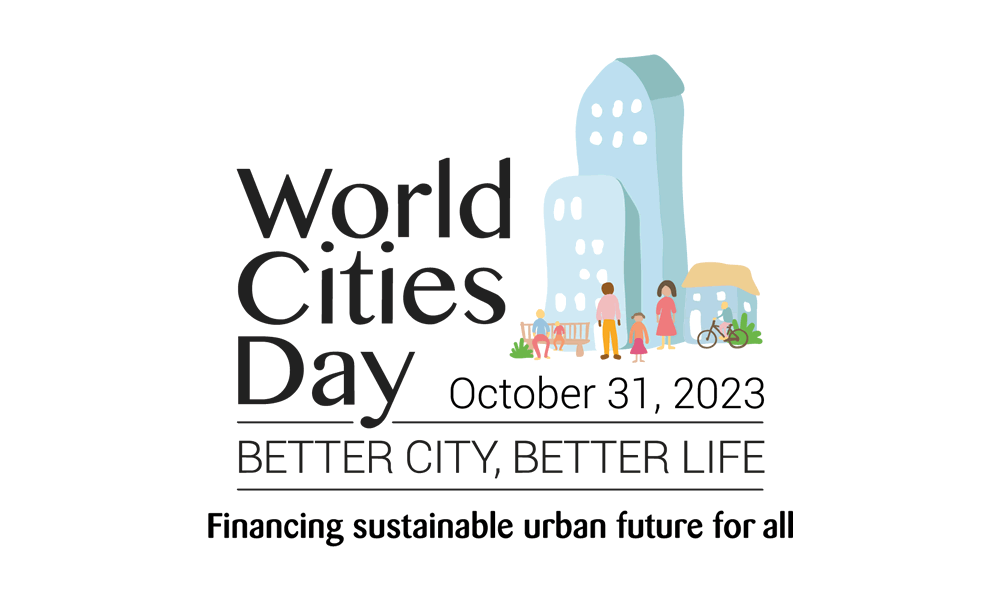« May 2010 | Main | July 2010 »
June 30, 2010
G-8 Summit Concludes in Muskoka, Canada
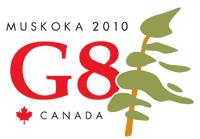

Photo: G-8 leaders gather around the table at the working session at the G-8 Summit in Huntsville, Ontario. (Photo © DFAIT Canada.)
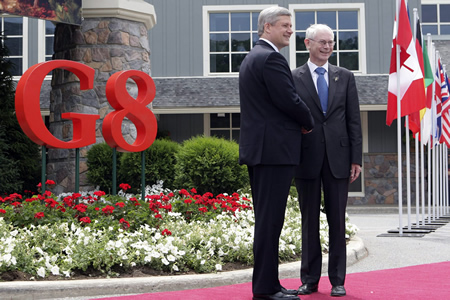
Photo: Canadian Prime Minister Stephen Harper welcomes Herman Van Rompuy, President of the European Council to the Muskoka G-8 Summit at the Deerhurst Resort in Huntsville, Ontario. (Photo © DFAIT Canada.)
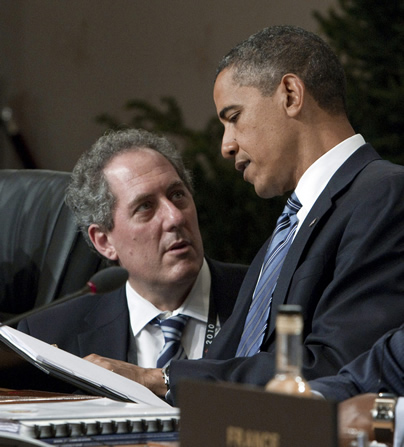
Photo: An aide talks to United States President Barack Obama at the leaders' working session at the G-8 Summit in Huntsville, Ontario. (Photo © DFAIT Canada.)

Photo: G-8 leaders walk down a path to pose for a leaders' group photo at the G-8 Summit in Huntsville, Ontario.
From the left:
• President of the European Commission: Jose Manuel Barroso,
• President of the Council of Ministers of the Republic of Italy: Silvio Berlusconi,
• President of the United States of America: Barack Obama,
• Chancellor of the Federal Republic of Germany: Dr. Angela Merkel,
• President of the European Council: Herman Van Rompuy,
• President of the French Republic: Nicolas Sarkozy,
• President of the Russian Federation: Dmitry Medvedev,
• Prime Minister of the United Kingdom: David Cameron,
• Prime Minister of Japan: Naoto Kan,
• Prime Minister of Canada: Stephen Harper.
(Photo © DFAIT Canada.)
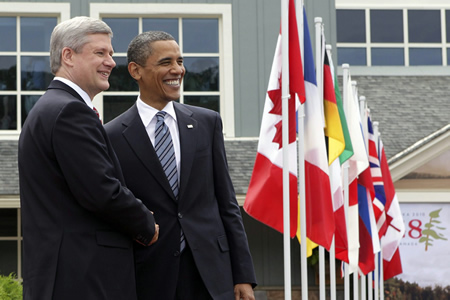
Photo: Canadian Prime Minister Stephen Harper welcomes United States President Barack Obama to the Muskoka G-8 Summit at the Deerhurst Resort in Huntsville, Ontario. (Photo © DFAIT Canada.)
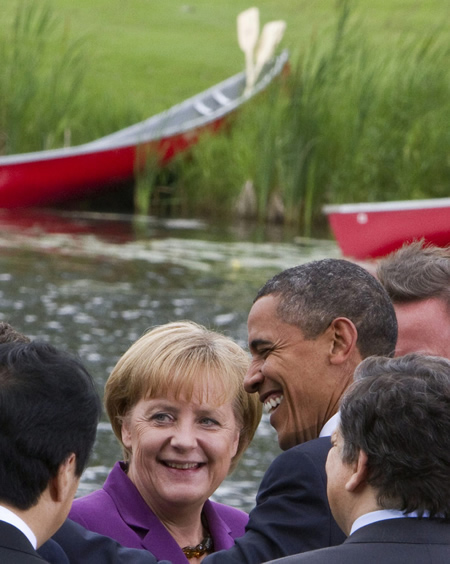
Photo: German Chancellor Angela Merkel and US President Barack Obama share a laugh as G-8 leaders pose for the leaders' group photo at the G-8 Summit in Huntsville, Ontario. (Photo © DFAIT Canada.)
• Canada hosted this year's G-8 summit on June 25-26 in Canada's Muskoka region.
The Group of Eight (G-8) brings together the world's major advanced economies--Canada, France, Germany, Italy, Japan, Russia, the United Kingdom and the United States.
The G-8 plays a leading role in international affairs. In partnership with the global community, it has helped establish concrete responses and gather significant resources to address critical global challenges in such areas as health, education and peace and security.
• G8 Summit 2010 Accountability Report: GET IT HERE
Source: Department of Foreign Affairs and International Trade, Government of Canada.
|GlobalGiants.Com|









Edited & Posted by the Editor | 5:31 AM | View the original post
June 25, 2010
First Lockheed Martin C-130J Super Hercules for India in Full Color

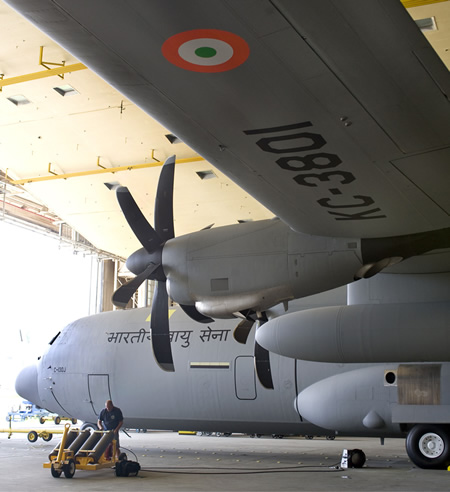
Photo: The first Lockheed Martin C-130J Super Hercules for India has completed painting at the company's Marietta, Georgia, facility. The aircraft now enters flight test in preparation for delivery at the end of the year. The program for India includes six C-130Js, training of aircrew and maintenance technicians, spare parts, ground support, and test equipment. Also included is India-unique operational equipment designed to increase Special Operations capabilities.

Photo: The Lockheed Martin C-130J Super Hercules airlifter pictured here flies over Niagara Falls on a test flight.

Photo: This aircraft is a Lockheed Martin C-130J, operated by the U.S. Coast Guard at Elizabeth City, N.C.
• Headquartered in Bethesda, Maryland, USA, Lockheed Martin is a global security company that employs about 136,000 people worldwide and is principally engaged in the research, design, development, manufacture, integration and sustainment of advanced technology systems, products and services.
Source: Lockheed Martin
|GlobalGiants.Com|







Edited & Posted by the Editor | 12:57 PM | View the original post
June 23, 2010
Global CEO Study by IBM Pinpoints Most Crucial Factor for Future Success -- CREATIVITY


• According to a major new IBM survey of more than 1,500 Chief Executive Officers from 60 countries and 33 industries worldwide, chief executives believe that -- more than rigor, management discipline, integrity or even vision -- successfully navigating an increasing complex world will require creativity.
Conducted through in-person interviews with consultants from IBM's Institute for Business Value, less than half of global CEOs believe their enterprises are adequately prepared to handle a highly volatile, increasingly complex business environment.

• CEOs are confronted with massive shifts - new government regulations, changes in global economic power centers, accelerated industry transformation, growing volumes of data, rapidly evolving customer preferences - that, according to the study, can be overcome by instilling "creativity" throughout an organization.
• More than 60 percent of CEOs believe industry transformation is the top factor contributing to uncertainty, and the finding indicates a need to discover innovative ways of managing an organization's structure, finances, people and strategy.

Managing Complexity
The CEOs interviewed told IBM that today's business environment is volatile, uncertain and increasingly complex.
Eight in ten CEOs expect their environment to grow significantly more complex but only 49 percent believe their organizations are equipped to deal with it successfully - the largest leadership challenge identified in eight years of research.
The CEOs said that the complexity of an interconnected world is aggravated by a number of factors. For example, CEOs expect revenue from new sources to double over the next five years and 76 percent of CEOs foresee the shift of economic power to rapidly developing markets.
Over the last four studies, the expected impact of technology on organizations has risen from 6th to 2nd place in importance, revealing that CEOs understand that technology and the interconnection of the world's infrastructures is contributing to the complexity they face, and also reveals that they need more technology-based answers to succeed in a world that is massively interconnected.

One World, Diverging Views
Vast complexity is further intensified by regional differences. The study noted that perspectives varied with geography - differences of opinion about what changes to make, what new skills will be needed and how to succeed in the new economic environment. These regional variations also compound the complexities with which CEOs must contend.
China proved much more resilient than the developed nations during the economic downturn. So, CEOs in China are, understandably, less concerned about volatility than CEOs in other regions. In fact, they are becoming increasingly confident of their place on the world stage.
But if China is to fulfill its global aspirations, it will need a new generation of leaders with creativity, vision and international management experience. Many of the country's CEOs recognize this; 61 percent believe "global thinking" is a top leadership quality.

• In North America, which faced a financial crisis that led to governments becoming major stake-holders in private enterprise, CEOs are more wary of "big government" than CEOs elsewhere. A full 87 percent anticipate greater government intervention and regulation over the next five years, compounding their sense of uncertainty.
In Japan, 74 percent of CEOs expect the shift of economic power from mature to rapidly developing markets to have a major impact on their organizations. By contrast, the European Union is less concerned about this shift, with only 43 percent of CEOs expecting to be impacted.
Understanding these and other sharp differences emerging by region is increasingly important as economies and societies become more closely linked. Organizations confront these differences as they increasingly operate across boundaries and across different regions.

• This study is the fourth edition of IBM's biennial Global CEO Study series. To better understand the challenges and goals of today's CEOs, IBM consultants met face-to-face with the largest-known sample of these executives. Between September 2009 and January 2010, IBM interviewed 1,541 CEOs, general managers, and senior public sector leaders who represent different sizes of organizations in 60 countries and 33 industries.
Source: IBM
|GlobalGiants.Com|
"I have only one counsel for you -- Be Master."
-- Napoleon Bonaparte to his brother, King Joseph of Spain.







Edited & Posted by the Editor | 1:01 PM | View the original post
June 20, 2010
RED BULL AIR RACE WORLD CHAMPIONSHIP 2010
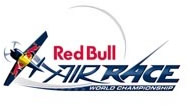
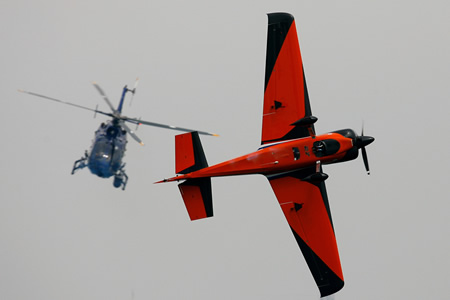
Photo: Nicolas Ivanoff of France in action on the Detroit River during the Red Bull Air Race Training day on June 3, 2010 in Windsor, Canada. (Photo by Dean Mouhtaropoulos/Getty Images for Red Bull Air Race. © 2010 Getty Images.)
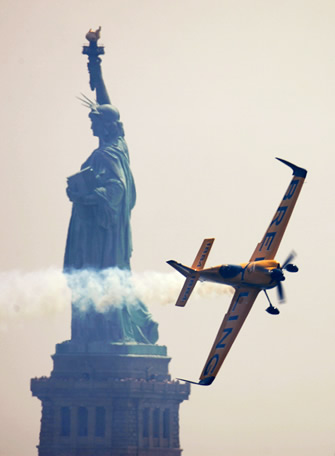
Photo: Nigel Lamb of Great Britain in action on the Hudson River during the Red Bull Air Race New York Race Day on June 20, 2010 in New Jersey. (Photo by Dean Mouhtaropoulos/Getty Images for Red Bull Air Race. © 2010 Getty Images.)
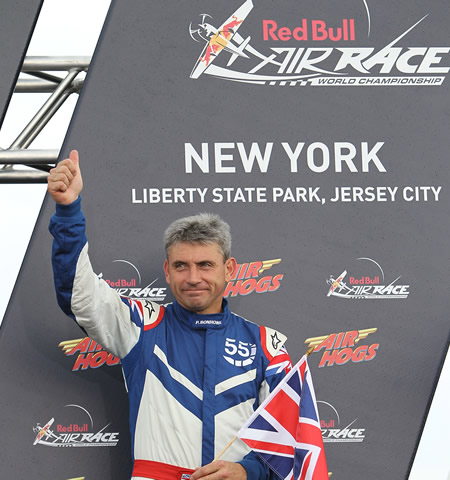
Photo: Paul Bonhomme of Great Britain celebrates his 1st Place after the Red Bull Air Race New York Race Day on June 20, 2010 in New Jersey. (Photo by Nick Laham/Getty Images for Red Bull Air Race. © 2010 Getty Images.)
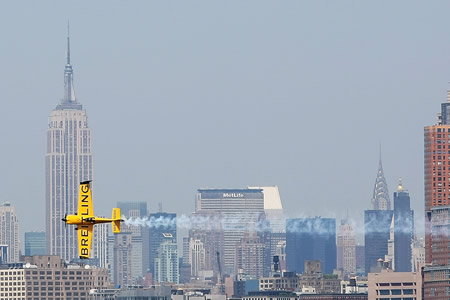
Photo: Nigel Lamb of Great Britain in action on the Hudson River during the Red Bull Air Race New York Qualifying Day on June 19, 2010 in New Jersey. (Photo by Nick Laham/Getty Images for Red Bull Air Race. © 2010 Getty Images.)
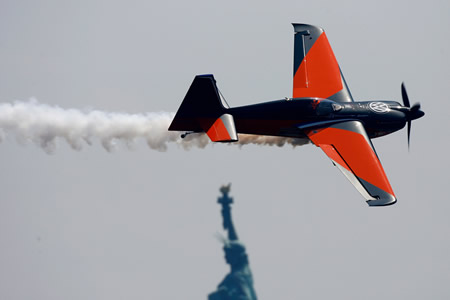
Photo: Nicolas Ivanoff of France in action on the Hudson River during the Red Bull Air Race New York Qualifying Day on June 19, 2010 in New Jersey. (Photo by Dean Mouhtaropoulos/Getty Images for Red Bull Air Race. © 2010 Getty Images.)

Photo: Adilson Kindlemann (C) of Brazil is pictured at the Race Airport during the Red Bull Air Race Calibration Day on June 16, 2010 in New Jersey. (Photo by Hamish Blair/Getty Images for Red Bull Air Race. © 2010 Getty Images.)
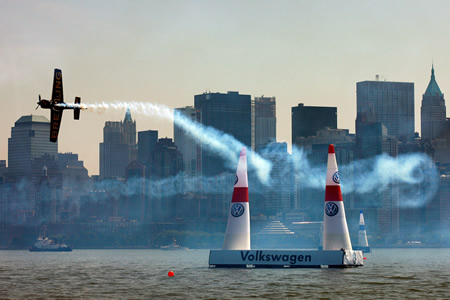
Photo: Nigel Lamb of Great Britain in action on the Hudson River during the Red Bull Air Race New York Training Day on June 18, 2010 in New Jersey. (Photo by Mark Thompson/Getty Images for Red Bull Air Race. © 2010 Getty Images.)

Photo: Sergey Rakhmanin of Russia in action on the Hudson River during the Red Bull Air Race New York Qualifying Day on June 19, 2010 in New Jersey. (Photo by Nick Laham/Getty Images for Red Bull Air Race. © 2010 Getty Images.)
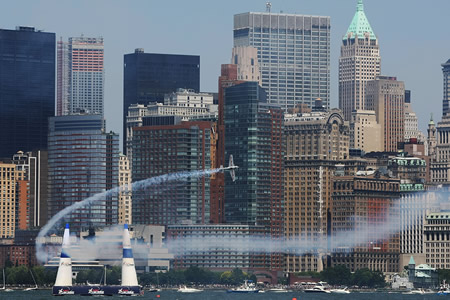
Photo: Hannes Arch of Austria in action on the Hudson River during the Red Bull Air Race New York Qualifying Day on June 19, 2010 in New Jersey. (Photo by Nick Laham/Getty Images for Red Bull Air Race. © 2010 Getty Images.)
• Paul Bonhomme of Britain won the first-ever Red Bull Air Race in New York on Sunday with a scintillating performance under pressure in front of the most spectacular setting in the eight-year history of the sport.
Nigel Lamb of Great Britain took second place in a thrilling four-way battle between the Statue of Liberty and Lower Manhattan while American Kirby Chambliss got his second straight podium with third place.
Bonhomme, the defending champion, prevailed in front of a huge crowd of 75,000 spectators watching from both sides of the Hudson River and a live U.S. television audience with one superb run after another through three pressure-packed rounds.
Bonhomme had finished behind Hannes Arch of Austria for the last three races and was desperate to get back on top after the Team Abu Dhabi racer cut his lead in the championship to just one point. Arch pushed Bonhomme to his limits but saw his three-race winning streak shattered in dramatic fashion when he hit a pylon in the final 4 ending any hope of a podium finish.
Bonhomme stopped the clock at 1:10.01, the day's fastest time on the 5.5-km track of 13 Air Gates set up on the majestic Hudson River between the Statue of Liberty and New York's breathtaking skyline.
Bonhomme had been the epitome of consistency with times of 1:10.09 in the Top 12 round and 1:10.07 in the Super 8 before lowering the mark again to 1:10.01 in the final. That was a full 2.05 seconds faster than Lamb and 2.08 faster than Chambliss of the USA. Hannes Arch of Austria was 5.34 back -- hurt by the six-second penalty for hitting the pylon.
It was Bonhomme's 12th straight podium, a record, and he now leads the championship with 53 points while Arch is second overall with 48 points. Team Breitling's Nigel Lamb is third on 47 and Chambliss has 35.
"It's very good, and what a setting," Bonhomme said. "I can appreciate the view now that I've finished racing. Great day. I concentrated on me, my airplane and the track. And now I think we can celebrate a bit." Lamb, who got his third second-place finish this year after getting the same result in Abu Dhabi and Rio de Janeiro, called it "a fantastic result". Chambliss, the 2006 world champion, was delighted to be on the podium in his home race. "As an American, I'm very, very proud," he said. "It'll sink-in in a while. I have to personally thank Hannes for hitting that gate. Thank you Hannes!"
Arch was gracious in defeat on the biggest stage in the 49-race history of the Red Bull Air Race, a city where organizers have dreamed of staging a race since the world's fastest growing motorsport was launched in 2003. It has been a FAI recognized world championship competition since 2005. Arch said he pulled out the stops to try to beat Bonhomme and get what would have been a record fourth straight victory and just barely hit the Air Gate, an inflatable pylon that he clipped with his wing.
"It was a good run," said Arch, the 2008 champion. "It was just a couple of centimeters that made the difference. I would rather lose here like that in style, going for it, than completely screw it up. So I think those guys in front of me owe me a beer."
The New York race was the fifth in the eight-race championship. It was a bit of a disappointment for the other American, Michael Goulian. The man from Massachusetts finished seventh. Pete McLeod of Canada, by contrast, had an excellent race and finished fifth to move up to fifth place in the championship with 29 points.
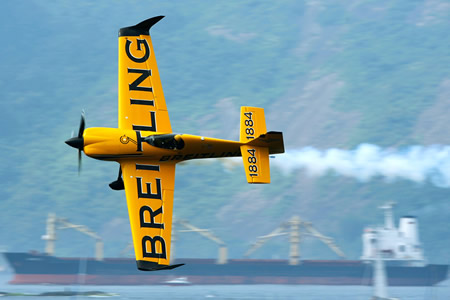
Photo: Nigel Lamb of Great Britain in action during the Red Bull Air Qualifying Day on May 8, 2010 in Rio de Janeiro, Brazil. (Photo by Dean Mouhtaropoulos/Getty Images for Red Bull Air Race. © 2010 Getty Images.)
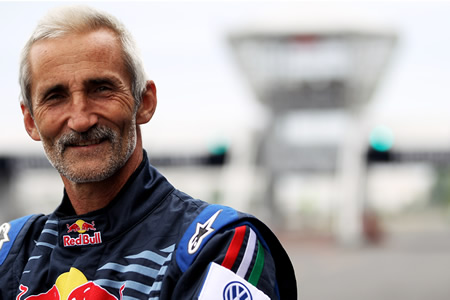
Photo: Peter Besenyei of Hungary looks on at the Race Airport during the Red Bull Air Race Calibration Day on June 16, 2010 in New Jersey. (Photo by Mark Thompson/Getty Images for Red Bull Air Race. © 2010 Getty Images.)
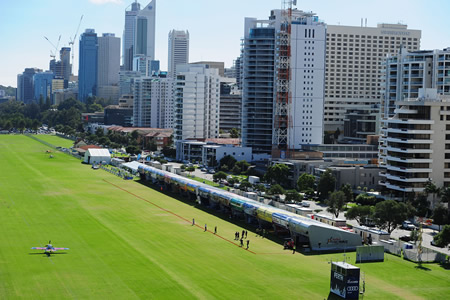
Photo: A general view of the Race Airport during the Red Bull Air Race Training Day Two on April 16, 2010 in Perth, Australia. (Photo by Mike Hewitt/Getty Images for Red Bull Air Race. © 2010 Getty Images.)
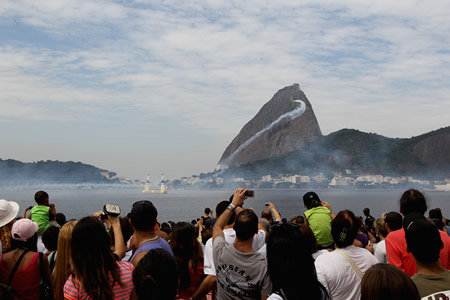
Photo: Fans on the beach watch Michael Goulian of USA in action during the Red Bull Air Qualifying Day on May 8, 2010 in Rio de Janeiro, Brazil. (Photo by Hamish Blair/Getty Images for Red Bull Air Race. © 2010 Getty Images.)
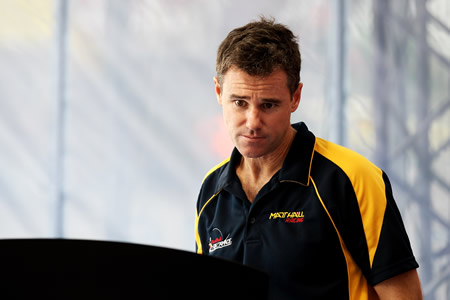
Photo: Matt Hall of Australia looks at a competitors plane at the Race Airport during the Red Bull Air Race Calibration Day on June 16, 2010 in New Jersey. (Photo by Mark Thompson/Getty Images for Red Bull Air Race. © 2010 Getty Images.)
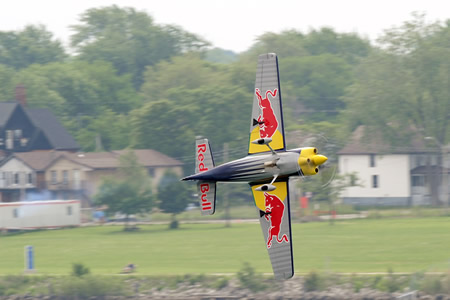
Photo: Peter Besenyei of Hungary in action on the Detroit River during the Red Bull Air Race Training day on June 3, 2010 in Windsor, Canada. (Photo by Harry How/Getty Images for Red Bull Air Race. © 2010 Getty Images.)
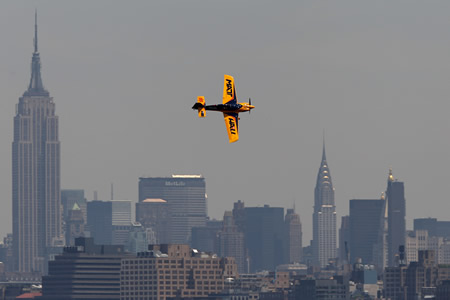
Photo: Matt Hall of Australia in action on the Hudson River during the Red Bull Air Race New York Training Day on June 18, 2010 in New Jersey. (Photo by Mark Thompson/Getty Images for Red Bull Air Race. © 2010 Getty Images.)

Photo: Matthias Dolderer of Germany in action during the Red Bull Air Race Training Day on May 6, 2010 in Rio de Janeiro, Brazil. (Photo by Ezra Shaw/Getty Images for Red Bull Air Race. © 2010 Getty Images.)
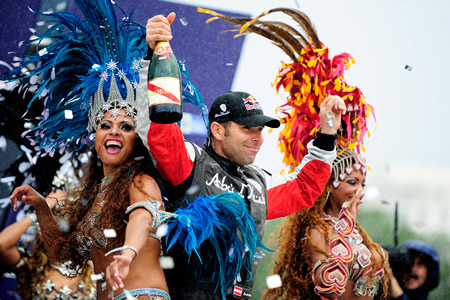
Photo: Hannes Arch of Austria celebrates his victory in the Red Bull Air Race Day on May 9, 2010 in Rio de Janeiro, Brazil. (Photo by Jamie McDonald/Getty Images for Red Bull Air Race. © 2010 Getty Images.)
• Just five years since it was officially launched, the Red Bull Air Race World Championship has evolved to become the most exhilarating motor sport on the planet. A combination of agility, high speed and extreme maneuverability, the low altitude competition demands exceptional flying skill from the world's most talented pilots.
8 races will take place on 5 continents in 2010.
RED BULL AIR RACE WORLD CHAMPIONSHIP - RACE CALENDAR 2010
1. 26/27 March Abu Dhabi, UAE
2. 17/18 April Perth, Australia
3. 8/9 May Rio de Janeiro, Brazil
4. 5/6 June Windsor, Canada
5. 19/20 June New York, USA
6.7/8 August EuroSpeedway, Lausitz, Germany
7. 19/20 August Budapest, Hungary
8. 4/5 September Lisbon, Portugal
|GlobalGiants.Com|







Edited & Posted by the Editor | 5:07 AM | View the original post
June 17, 2010
Global Peace Index 2010
• World Less Peaceful in 2010.
• Violence Impacting Global Economy $7 Trillion Annually.
• New Zealand tops rankings for second consecutive year.
• 4-year trends show Middle East and Africa with most gains in peacefulness.
• South Asia sees sharpest fall in peace.
• Military spending as a % of GDP reaches its lowest point in 4 years.

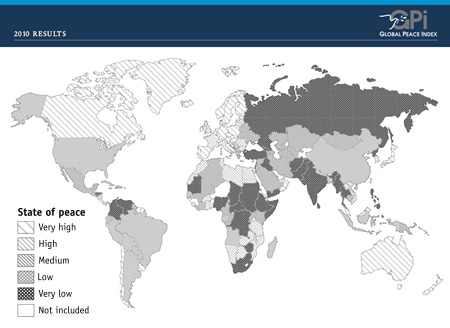
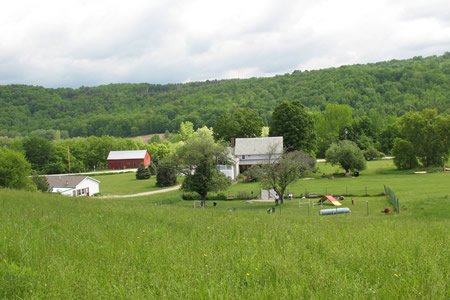
The world became less peaceful for the second consecutive year, according to the just published fourth annual Global Peace Index (GPI). As the global economy continues to falter, this year's data shows an intensification of conflicts and growing instability linked to the downturn that began in 2008, with several countries seeing sharp increases in homicides, violent demonstrations and fear of crime.
The increase in violence is depriving the global economy of assets when they are needed most. A 25 percent reduction in global violence would free up $1.8 trillion USD annually -- enough to pay off Greece's debt, fund the achievement of the Millennium Development Goals (MDGs) and meet the EU's 20-20-20 climate and energy targets.

The only study to quantify global peacefulness, the GPI is produced by the Institute for Economics and Peace (IEP). This year it has expanded to rank 149 independent states. Composed of 23 qualitative and quantitative indicators, it combines internal and external factors ranging from military expenditure to relations with neighboring countries and levels of violent crime.
• Global Peace Index (GPI) 2010: Rankings for 149 Countries
"The research carried out by the IEP based on 4 years of GPI data provides a quantifiable demonstration that improving peace can transform the global economy and unleash the wealth needed to tackle debt, fund economic expansion and create a more sustainable environment," said Steve Killelea, founder of the GPI.
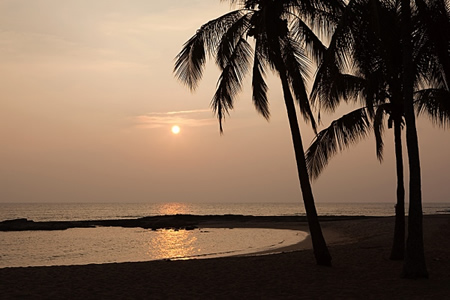
Top-ranked New Zealand was one of only three countries in the top ten to improve in peacefulness in the 2010 Index. Iceland moved into the #2 spot as the country's economy stabilised after falling to #4 in last year's ranking, the improvement demonstrating the resilience of peaceful nations.
Despite the global slide, the Middle East & North Africa and Sub-Saharan Africa have made the most gains since the research began in 2007. Reasons for the improvement vary, but include more political stability and a drop in military expenditure in the Middle East & North Africa and less access to weapons, a decrease in conflicts and better relations with neighboring countries in Sub-Saharan Africa.

Conversely, South Asia saw the greatest decrease in peacefulness, as a result of increased involvement in internal conflicts. The main countries experiencing decreases in peacefulness were India, Sri Lanka and Pakistan.
The US improved its 2010 score but slipped three spots down the index due to the addition of new countries and the re-rating of the number of heavy weapons.
Western Europe continues to be the most peaceful region, with the majority of the countries ranking in the top 20. All five Scandinavian nations rank in the top ten; however, Denmark dropped five spots to #7.
Iraq, Somalia and Afghanistan were the least peaceful countries for the second consecutive year. Syria, Georgia, the Philippines, Russia and Cyprus were this year's biggest fallers.

• The GPI was founded by Killelea, an Australian international technology entrepreneur and philanthropist. It forms part of the Institute for Economics and Peace, a global think tank dedicated to the research and education of the relationship between economics, business and peace. An international panel of experts in the study of peace advises on the identification and weighting of indicators in the GPI, which is compiled by the Economist Intelligence Unit.
Source: Institute for Economics and Peace
|GlobalGiants.Com|
"These six things doth the LORD hate: yea, seven are an abomination unto him:
A proud look, a lying tongue, and hands that shed innocent blood,
A heart that deviseth wicked imaginations, feet that be swift in running to mischief,
A false witness that speaketh lies, and he that soweth discord among brethren."
-- Proverbs of Solomon 6:16-19.
"There be three things which go well, yea, four are comely in going:
A lion which is strongest among beasts, and turneth not away for any;
A greyhound; A he-goat also;
And a king, against whom there is no rising up."
-- Proverbs of Solomon 30:29-31.
[A lion marches on and does not alter his pace or quit his path when other animals come in his way. A greyhound (fastest hunting dog) remains ready for his course and performs it with swiftness. A he-goat walks in front of the flock, as one careful about it, and attentive to its safety. And a king goes gracefully when he reigns in the hearts of his people, and commands a unanimous, victorious army (visible or invisible), whom none dare oppose.]







Edited & Posted by the Editor | 2:23 AM | View the original post
June 16, 2010
Longines Prize for Elegance 2010
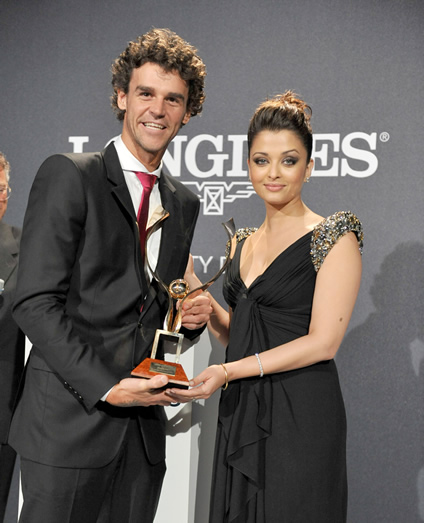
Photo: Gustavo Kuerten (Winner of 2000 French Open) receiving the Longines Prize for Elegance from the Indian actress Aishwarya Rai Bachchan.
After the exhibition match that rounded up the Longines Future Tennis Aces tournament, Longines organized a charity dinner to raise funds for the charity organizations run by its two ambassadors of elegance Andre Agassi and Stefanie Graf.
The Indian actress and Bollywood star Aishwarya Rai Bachchan and the two winners of the French Open at Roland Garros in 2000 - Mary Pierce and Gustavo Kuerten - were among the 400 guests from all around the world at this elegant dinner in Paris, France.
During the evening the famous Swiss watchmaker presented the Longines Prize for Elegance to Gustavo Kuerten in recognition of his work with disadvantaged children, notably through his foundation, the Instituto Guga Kuerten.
The 3-time winner of Roland-Garros was presented with the Longines Prize for Elegance by the Indian actress Aishwarya Rai Bachchan.
Based in St. Imier in Switzerland since 1832, the watchmaker Longines has been timekeeper for world championships in various sports. With the winged hourglass as its emblem, the brand has outlets in over 130 countries.
|GlobalGiants.Com|







Edited & Posted by the Editor | 6:56 AM | View the original post
June 13, 2010
World's Fastest Yacht, Esimit Europa 2, Officially Launched in Cannes, France
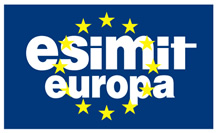

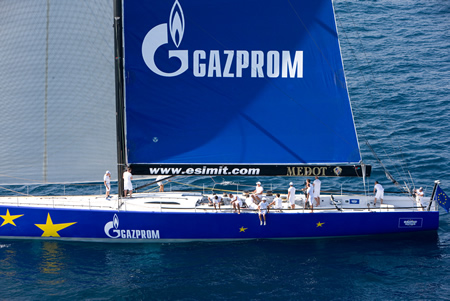
CANNES, FRANCE: The highly anticipated Esimit Europa 2 yacht has been introduced to the global audience at its christening ceremony, which was attended by numerous business leaders and project supporters.
• The 30-meter long and 44-meter high giant is the fastest yacht in the world.
Under the patronage of Jose Manuel Barroso, the President of the European Commission, the yacht is building upon its 15-year tradition of connecting European nations.
Speaking at the launch ceremony, Slovenian Igor Simcic, the yacht's owner and Esimit Europa project General Manager, outlined the team's goals, which will compete in the 5 most prestigious European regattas as an ambassador of the European Energy movement.
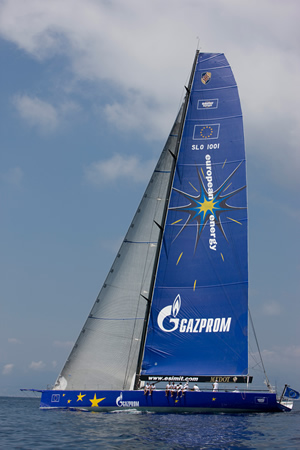
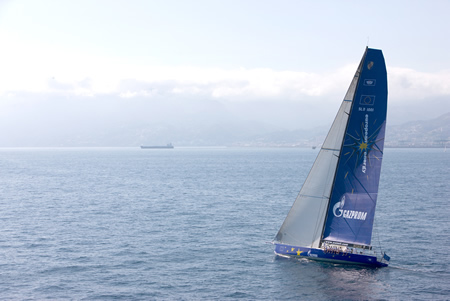
The 26-member crew will man one of world's most advanced yachts. The plan is to achieve an overall victory in all attended regattas. "Nothing in the Esimit Europa project is left to coincidence. Representing the entire Europe is a great honor and a great responsibility. I am glad that the yacht has become a symbol for the united Europe, a symbol that is sorely lacking. Each victory will therefore strengthen the pride in being a European and we will not be ashamed to raise the European flag as we cross the finish line," briefly explained Igor Simcic.
Source: Esimit Europa
|GlobalGiants.Com|







Edited & Posted by the Editor | 1:23 AM | View the original post
June 12, 2010
FIFA World Cup and the Economy: ING Studies Correlation Between the Two

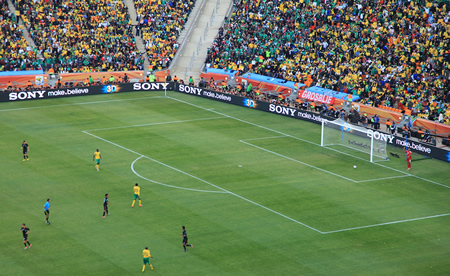
Photo: General view during the 2010 FIFA World Cup South Africa Group A match between South Africa and Mexico at Soccer City Stadium on June 11, 2010 in Johannesburg, South Africa. (Photo by David Cannon/Getty Images for Sony. © 2010 Getty Images)
• Brazilians Would pay Most for World Cup Title
Brazilians would be willing to pay more than 800 euros each in exchange for the World Cup football title. Together with the Portuguese (368 euros), they would be prepared to dig deepest into their pockets in exchange for the World Cup glory. At 47 euros a head the Dutch are more frugal, but still more generous than the Germans or Japanese. Brazilians are also the most optimistic about their chances, with nearly three out of four people surveyed believing the 'divine canaries' will take the title. Other countries also see Brazil as hot favourites, with only the Argentineans and the Spaniards believing they have a better chance of winning than the Brazilians. To support their national teams, consumers will be buying masses of fan gear over the next few weeks. On average the French and English will spend 15 euros each, with the Spanish buying more than 27 euros worth of gear and souvenirs. These are some of the findings of a comprehensive study by ING into the correlation between the World Cup and the economy.

Photo: Steven Pienaar of South Africa and Gerardo Torrado of Mexico compete for the ball during the 2010 FIFA World Cup South Africa Group A match between South Africa and Mexico at Soccer City Stadium on June 11, 2010 in Johannesburg, South Africa. (Photo by Clive Mason/Getty Images for Sony. © 2010 Getty Images)
• Impact of the World Cup on the economy
As the main sponsor of the Dutch national squad, ING is launching various initiatives in connection with the World Cup. One of these is the 'ING WK-nomie' (ING World Cup-onomics) study. Charles Kalshoven, chief economist at the ING Economic Bureau Retail Netherlands: "The further the Dutch go, the better it will be for the Dutch economy. A similar effect can be seen in other participating countries. The impact of the World Cup can be felt in the workplace and in shops, but also in consumer confidence and spending."

Photo: Giovani Dos Santos of Mexico controls the ball during the 2010 FIFA World Cup South Africa Group A match between South Africa and Mexico at Soccer City Stadium on June 11, 2010 in Johannesburg, South Africa. (Photo by Michael Steele/Getty Images for Sony. © 2010 Getty Images)
• Sacrificing days off to win the World Cup
In the Netherlands one in every five people would be prepared to give up more than a full working week in days off in exchange for winning the World Cup. As with putting a price tag on winning the World Cup, most other countries are more generous in this respect. In Brazil and Argentina, 72% and 79% of the population, respectively, would be willing to sacrifice days off. On average they would gladly lose three full working weeks of holidays in exchange for winning the title. In contrast, the Japanese and Americans would be less prepared to give up their days off.
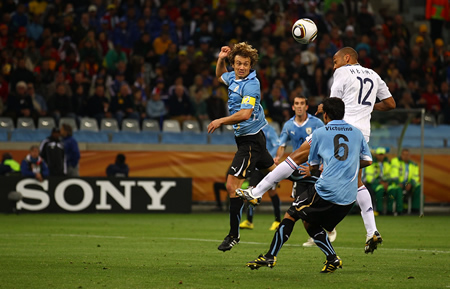
Photo: Thierry Henry (R) of France takes a shot at goal during the 2010 FIFA World Cup South Africa Group A match between Uruguay and France at Green Point Stadium on June 11, 2010 in Cape Town, South Africa. (Photo by Lars Baron/Getty Images for Sony. © 2010 Getty Images)
• Anglo countries watch fewer World Cup games
Enthusiasm for the World Cup differs from country to country. For example, 58% of Americans say they will not be watching any World Cup games. Remarkably, a large percentage of people in other English-speaking countries - England (42%), Australia (43%) - will not be watching games either. Many fans in Mexico and Portugal watch the games in bars (28% and 26%, respectively), whereas Portuguese people prefer watching the games at home and Brazilians get together with family and friends.
To underpin their support for their national teams, people are stocking up on fan gear. On average the Dutch are spending 5 euros while the French and English are buying 15 euros worth of gear per person. The Spanish are spending even more: on average 27 euros each.

Photo: Nicolas Anelka of France and Diego Lugano of Uruguay compete for the ball during the 2010 FIFA World Cup South Africa Group A match between Uruguay and France at Green Point Stadium on June 11, 2010 in Cape Town, South Africa. (Photo by Jamie McDonald/Getty Images for Sony. © 2010 Getty Images)
• Social significance of football
The way that people experience the World Cup and the value they attach to winning it appear to be linked to the social significance a country attaches to football. ING asked people in 12 participating countries which career they would ideally choose for their sons. Brazilians (39%) and Argentineans (32%) dream most of a professional football career for their sons, followed by Spaniards and Mexicans (both 29%). This preference was the weakest in Germany and Japan at a mere 7%. The Dutch would most like to see their sons become company executives (61%), with a professional football career in third place (13%) - still well ahead of a career as a movie star (4%) or Prime Minister (only 2%).

Photo: Singer Shakira poses for photographs during Sony World Cup Opening 3D Launch Show at Nelson Mandela Square on June 8, 2010 in Johannesburg, South Africa (Photo by Jim Dyson/Getty Images for Sony. © 2010 Getty Images).
• Brazilians and Spaniards most confident about own chances
Brazilians are most confident about their own team with nearly three-quarters of the people surveyed expecting the 'divine canaries' to take the cup home. Brazil are also hot favourites with people surveyed in other countries. Only Argentina and Spain believe they have a better chance of winning than Brazil.
On average, Spaniards give themselves a 58% chance of taking the cup home. Argentineans also have faith in their national squad and think they have a 48% chance of winning for the first time since 1986. The Dutch give their squad a 34% chance of success. Remarkably the Mexicans have more faith in the Dutch team than the Dutch do, while Italians are least convinced that the Dutch will hoist the trophy.
• ING is a global financial institution of Dutch origin with more than 85 million customers in Europe, the US, Canada, Latin-America, Asia and Australia. ING Bank N.V. is headquartered in Amsterdam, The Netherlands.
Source: ING
• The Castrol Predictor: Who will win the World Cup?
(Two of the world's most passionate footballing nations, Spain and Brazil, are favorites to go head to head in the 2010 FIFA World Cup(TM) Final according to the Castrol Predictor, a new tool launched by 2010 FIFA World Cup(TM) sponsor Castrol. The Castrol Predictor, uses objective analysis and highly advanced technology to offer unique insights into winning performances.)
|GlobalGiants.Com|







Edited & Posted by the Editor | 3:56 AM | View the original post
June 11, 2010
World Record for Swedish Painting
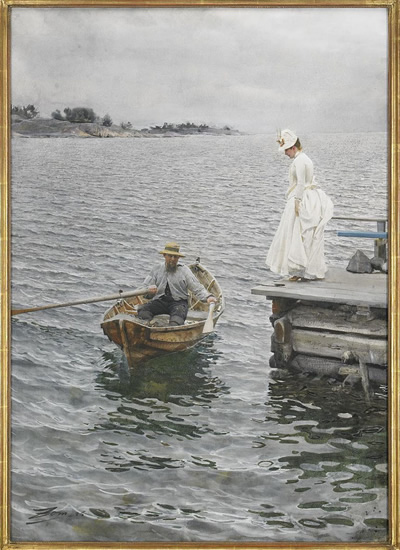
Photo: An Anders Zorn painting that sold for 2.6 million euros excluding commission.
26,000,000 SEK excluding commissions (2,600,000 euros) was paid for the masterpiece Sommarnoje by the Swedish artist Anders Zorn at Stockholms Auktionsverk in Stockholm. This is a world record for a Swedish artist and the highest price ever paid at an auction in Sweden.
This watercolour was painted in 1886 at Dalaro.
• Anders Zorn is considered one of the world's foremost watercolor painters and his skills depicting the variations and reflections of the water's surface are unsurpassed in this very difficult technique.
Source: Stockholms Auktionsverk
|GlobalGiants.Com|







Edited & Posted by the Editor | 12:48 AM | View the original post
June 9, 2010
IBM Addresses Complexity in Automotive Systems
Automotive Manufacturers Gain Competitive Edge through Telematics.

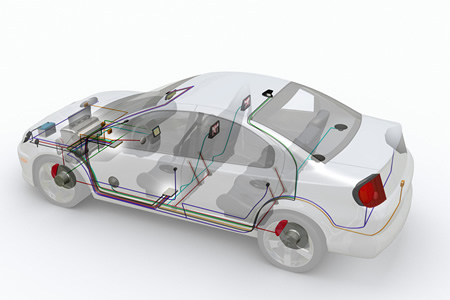
Photo: By 2011, 45% of all cars will provide interconnected services involving dozens of service providers ranging from insurance, to safety to navigation. In fact, the average automobile contains several millions of lines of code, which help to facilitate this. IBM has collaborated with Hughes Telematics, Inc. to address the growing complexity of designing and managing automotive systems by developing a software platform that quickly delivers telematics services to its customers. (Foto/IBM. Image courtesy of Hughes Telematics, Inc.)
• IBM today announced it has teamed with industry leading manufacturers, Hughes Telematics, Inc. (HTI) and Daimler Fleetboard GmbH, to address the growing complexity of designing and managing automotive systems. The companies have collaborated with IBM to develop software platforms that more quickly deliver telematics services to their customers.
Although vehicles are becoming more complex they are also becoming smarter. The intersection of information and communications technology, also known as telematics, is expected to be a standard feature in vehicles by 2015 according to ABI Research.
• The use of telematics allows vehicles to be connected in ways that are designed to enhance the driving experience for consumers, or increase the operational effectiveness of transportation companies.


Automotive manufacturers are also facing the challenge of having to integrate a growing amount of software, mechanical and electronic technologies across a vast ecosystem of suppliers. Additionally, these technologies need to be tracked and managed as they evolve over twenty-years -- the average life-span of a vehicle.
Further contributing to this challenge, the evolution of automotive control electronics is expanding at a rapid rate. In 1990, the amount of electronics and software in a vehicle accounted for less than 16 percent of the vehicle's total value. Today, that share is projected to account for almost 40 percent of the value of a new vehicle.
Due to this exponential growth in the automotive electronics industry, owning a modern vehicle is equivalent to operating thirty or more computers on wheels. In fact, as explained by IBM, the average automobile now has several millions of lines of code -- more than that of a space shuttle.
|GlobalGiants.Com|
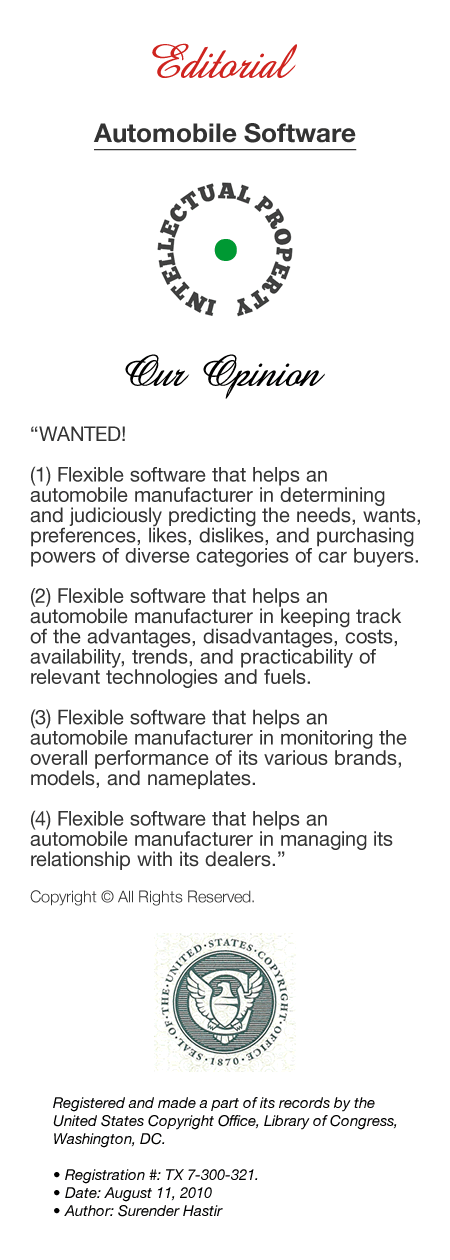








Edited & Posted by the Editor | 10:25 AM | View the original post
June 7, 2010
Academic Reputation Survey
• Thomson Reuters Academic Reputation Survey Shows High Level of Engagement From Global Scholarly Community.
• Nearly one third of responses came from Asia.

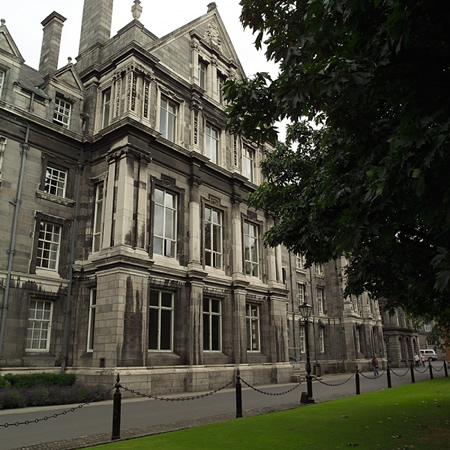
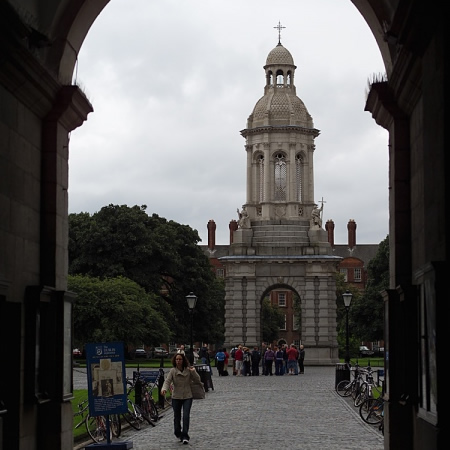
Photos: Trinity College (Dublin, Ireland).
Thomson Reuters has announced preliminary results of its Academic Reputation Survey. The survey received responses from professional scholars from every corner of the world.
Thousands of responses were received in six subject areas: engineering and technology; physical sciences; life sciences; clinical, preclinical and health; social sciences; and arts and humanities. Nearly one third of these responses came from Asia, including a strong representation from China and Japan.
"We're particularly pleased with the number of responses from the Asia Pacific region," said Jonathan Adams, director of research evaluation at Thomson Reuters. "As other surveys have been criticized for over-representing North America and Europe, we took particular care to better balance regional representation."

To help control for language and translation bias the Academic Reputation Survey was offered in eight languages: Japanese, Simplified Chinese, Spanish, French, German, Brazilian Portuguese, European Portuguese and English.
"Interestingly, country affiliation did not always predict language usage," Adams added. "For example, many United States-based participants took the survey in Chinese -- illustrating a highly mobile global academic community."

The Academic Reputation Survey is part of the Thomson Reuters Global Institutional Profiles Project. The initiative will create data-driven profiles of globally significant research institutions/universities -- combining reputation feedback, scholarly outputs, citation patterns, funding levels, and faculty characteristics across disciplines in one comprehensive database. The data can be packaged and analyzed to different specifications, giving organizations custom information for evaluating and benchmarking their performance and supporting efforts to secure research funding.
• The data gathered for the Global Institutional Profiles Project will also help inform the Times Higher Education's influential World University Rankings.
• Thomson Reuters is analyzing the Academic Reputation Survey and would soon release the detailed results.
|GlobalGiants.Com|







Edited & Posted by the Editor | 6:46 AM | View the original post
June 5, 2010
The ENERGY GLOBE World Award goes to India
• Winner: India.
• Top environmental gala televised worldwide from Rwanda.


Photo: Moderator: Desirée Nosbusch, Winner Bhagwati Prasad Agrawal, Award Presenter: UNEP Executive Director Achim Steiner.
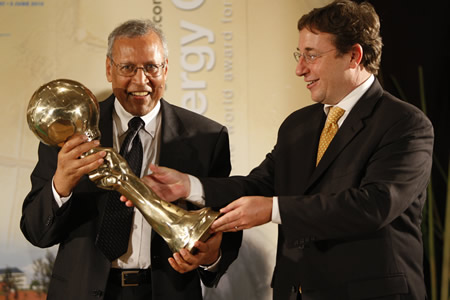
Photo: Winner Bhagwati Prasad Agrawal, Award Presenter: UNEP Executive Director Achim Steiner.
Top-ranking UN VIPs, famous environmental champions, a glamorous gala, and, above all, the world's best environmental projects comprised the ENERGY GLOBE Gala Rwanda 2010. This year the top environmental gala served as the official opening event for the UN World Environment Day.
Before a full house, environmental VIPs delivered the introductions: top Rwandan politicians, UNEP Executive Director Achim Steiner, UNEP climate hero Luo Hong, Peter Rae (vice president of the environmental initiative REN21) and Ian Redmond (patron of the Great Apes Survival Project).
As the winner of the ENERGY GLOBE in the category Water was announced, emotions began to rise in the hall: Rejoicing erupted among the team of a project from India, "River from Heaven", which works to supply water to rural areas. Then everything went quickly at the Awards: The ENERGY GLOBE in the category Earth went to Mauritius, where "Seeds of Hope" achieves reforestation and biodiversity. The award for the category Fire distinguished floating power plants in Norway. In the category Air, a CO2 saving engine from Taiwan took the prize. The Youth winner was a school self-sufficiency concept from Argentina that provides healthy nutrition for pupils and teaches them cultivation.
The ENERGY GLOBE World Award goes to ...
The climax was the selection of the ENERGY GLOBE World Award by the audience. Moderator Desirée Nosbusch talked with UNEP Executive Director Achim Steiner, the award presenter, about World Environment Day. Meanwhile in the background the audience votes were being counted. Then finally came the announcement: With a clear margin, the victory went to the winner of the Water Award, India!
However, the nominees were not the only excitement: During the Gala and at the after-show concert, pop and chanson diva Viktor Lazlo delivered samba flair. Inganzo Ngali, Rwanda's best-known folklore group, added local color to the Gala.
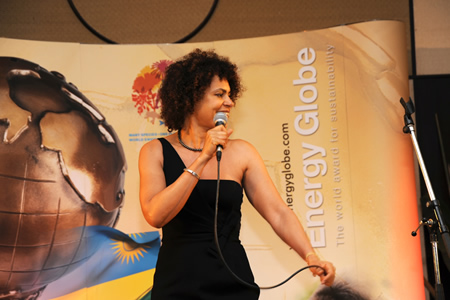
Photo: Viktor Lazlo performing at the gala.
• The impressive and committed projects that received the awards ensured that this high-class gala did not lose sight of its actual purpose. These projects made the glamorous festival a highly visible signal for sustainability and environmental awareness.
• The ENERGY GLOBE World Award is an annual event honoring top environmental projects from around the world. It was established in 2000 by Wolfgang Neumann from Austria and has become the most prestigious international environmental prize. Every year approximately 1000 projects are submitted by over 100 countries for the prize, which is awarded in the categories earth, fire, water, air and youth.
The nominees:
Category Earth:
• Federated States of Micronesia: On the island of Korae, Micronesia Eco Inc. has established a recycling system that conserves resources and generates income for inhabitants.
• Mauritius: The seedling program of Flora Marketing CO LTD offers residents new sources of income while ensuring biodiversity and combating massive deforestation.
• Austria: Meeting the German passive house standard with the renovation of an energy-hungry old apartment building was a challenge. A special solar façade enabled GIWOG to succeed.
Category Fire:
• Bangladesh: Shobuj Angira Foundation supplies portable solar energy in rural Bangladesh. Centrally located solar panels and portable batteries now bring light to villagers.
• Nepal: The improved water mills of the Centre for Rural Technology not only make work easier; they also deliver urgently needed, clean power in rural Nepal.
• Norway: Statoil ASA New Energy has constructed a prototype of a floating wind power plant. Now wind energy can also be harvested on the open sea.
Category Water:
• India: Networked underground rain water tanks supplied by Sustainable Innovations already provide 10,000 residents of rural India with clean drinking water.
• Pakistan: The extensive water and hygiene program of Aga Khan Planning and Building Service delivers water supply systems and health training to Pakistani villages.
• Germany: HelioTech Türk GmbH has implemented an economical desalination plant that uses solar energy to make salt water drinkable and works even in remote areas.
Category Air:
• Taiwan: Less CO2 through more efficient engines was the idea behind Epoch Energy Technology Corp.'s Hybrid Fuel System. It can be retrofitted into any engine and produces a hydrogen/oxygen mixture as additional fuel.
• USA: The city of Ann Arbor, Michigan, has saved money and energy since transforming its street lighting to LEDs. This perfectly combines economy and CO2 reduction.
• Sweden: The Malmö Environment Department supports public photovoltaic projects and so advertises for CO2-free energy production.
Category Youth:
• Argentina: The self-sufficiency program of CiudadanÃa Solidaria provides healthy nourishment at the school in La Soledad while teaching pupils and teachers about sustainable organic farming.
• Slovenia: The project "Ustanova Ekosola kot nacin zivljenja" lets pupils in the school center in Velnje test how energy saving works. This prototype is affecting all of Slovenia.
• Morocco: Under the motto "Ecology live", the Mohammed VEX Foundation for Environment Protection supports schools toward becoming eco-schools.
Source: Energy Globe Foundation
|GlobalGiants.Com|







Edited & Posted by the Editor | 11:21 AM | View the original post
June 4, 2010
World Environment Day: United Nations International Children's Painting Competition
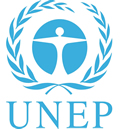
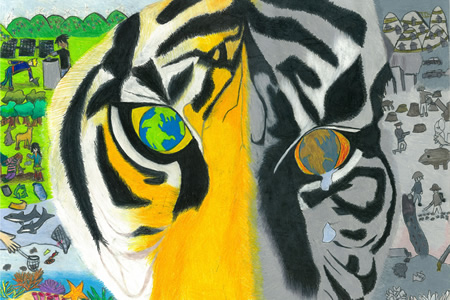
Photo: Sylvia Gong, an eighth grader at Hopkins Junior High School in Fremont, California, won the United Nations Environment Programme's (UNEP) International Children's Painting Competition (ICPC) in North America. Gong's painting portrays a tiger grieving over a world where human activities are depleting resources.
• Sylvia Gong, an eighth grader at Hopkins Junior High School in Fremont, California, received the top North American prize in the United Nations Environment Programme's (UNEP) 19th annual International Children's Painting Competition (ICPC). Her painting addresses the theme, "Biodiversity - Connecting with Nature."
Gong was honored at the Children's Museum of Pittsburgh as Bayer Corporation and UNEP unveiled the 2010 ICPC Exhibition to herald World Environment Day celebrations in Pittsburgh, this year's North American host city. The 77-picture exhibition features the three winning paintings, including Gong's portrayal of a tiger grieving over a world where human activities are depleting resources.
Her first place award included a $1,000 cash prize and an all-expense paid trip for her and a chaperone to UNEP's TUNZA International Children's Conference in Nagoya, Japan, in October. While there, she will join the first place winners from UNEP's six global regions. This year, nearly 1.1 million paintings from 88 countries were received.

The ICPC is a signature event of UNEP's annual World Environment Day celebrations. The painting competition is sponsored globally by Bayer AG, an international health care, nutrition and high-tech materials group headquartered in Germany.
Established in 1991 and organized annually by partners UNEP, Bayer AG, Nikon and the Foundation for Global Peace and the Environment, the ICPC invites elementary and middle school students, ages six to 14, to learn about the environment and express that knowledge creatively through art.
Regional winners are selected from UNEP's six regions including North America; Africa; Asia and the Pacific; West Asia; Latin America and the Caribbean; and Europe. They are announced during the six-week period between Earth Day in April and World Environment Day on June 5.
|GlobalGiants.Com|







Edited & Posted by the Editor | 11:26 AM | View the original post
Widely-Used World University Ranking now on iPhone
• QS World University Rankings now an iPhone App.
• Top 500 Universities in the World can be contacted at the Touch of a Button.

The world's most popular university ranking is now accessible to its diverse users via an innovative new iPhone Application. The QS World University Rankings Application designed for students, parents and ranking fanatics, allows users to conduct their own study destination research by providing global, regional and subject-based rankings as well as profiles and contact details of 500 of the world's top universities.

QS World University Rankings can be viewed and interpreted in three different ways - globally, regionally and by subject area. Users who have reviewed the App said it is, "Very thorough and organized", and also "Great to be able to see info about the universities I'm interested in all in one place".
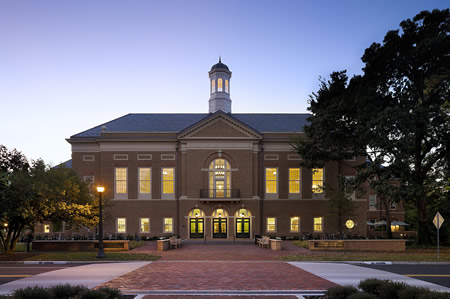
The iPhone App is the first of a series of initiatives to be launched by QS in the lead up to the release of the 2010 QS World University Rankings; it is free to download on iTunes.
|GlobalGiants.Com|







Edited & Posted by the Editor | 1:59 AM | View the original post
June 3, 2010
International Space Station Expedition 23 Crew Lands Safely


Photo: A family of Osprey are seen outside the NASA Kennedy Space Center Vehicle Assembly Building (VAB) in Cape Canaveral, Fla. on Thursday, May 13, 2010. Photo Credit: (NASA/Bill Ingalls)

Photo: Russian cosmonaut Expedition 23 Flight Engineer Mikhail Kornienko smiles as he awaits to have his Sokol suit pressure checked prior to launch, Friday, April 2, 2010, in Baikonur, Kazakhstan. Kornienko and fellow Expedition 23 crew members Soyuz Commander Alexander Skvortsov and NASA Flight Engineer Tracy Caldwell Dyson launched in their Soyuz TMA-18 rocket from the Baikonur Cosmodrome in Kazakhstan on Friday, April 2, 2010. Photo Credit: (NASA/Bill Ingalls)
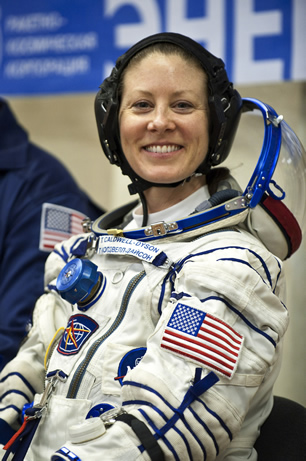
Photo: Expedition 23 NASA Flight Engineer Tracy Caldwell Dyson of the U.S. prepares to have her Russian Sokol suit pressure checked at the Baikonur Cosmodrome in Baikonur, Kazakhstan, Friday, April 2, 2010. Caldwell Dyson and fellow Expedition 23 crewmembers Soyuz Commander Alexander Skvortsov and Flight Engineer Mikhail Kornienko of Russia launched in their Soyuz TMA-18 rocket from the Baikonur Cosmodrome in Kazakhstan on Friday, April 2, 2010. Photo Credit: (NASA/Carla Cioffi)

Photo: The Soyuz TMA-18 spacecraft is rolled out by train to the launch pad at the Baikonur Cosmodrome, Kazakhstan, Wednesday, March, 31, 2010. Photo Credit: (NASA/Carla Cioffi)

Photo: Pad technicians secure the Soyuz TMA-18 spacecraft shortly after it was rolled out by train to the launch pad at the Baikonur Cosmodrome, Kazakhstan, Wednesday, March, 31, 2010. Photo Credit (NASA/Bill Ingalls)
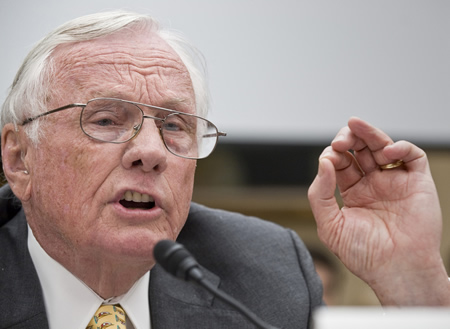
Photo: Apollo 11 Commander Neil Armstrong (first person to set foot on the Moon) makes a point as he testifies during a hearing before the House Science and Technology Committee, Tuesday, May 26, 2010, at the Rayburn House office building on Capitol Hill in Washington. The hearing was to review proposed human spaceflight plan by NASA. Photo Credit: (NASA/Paul E. Alers)
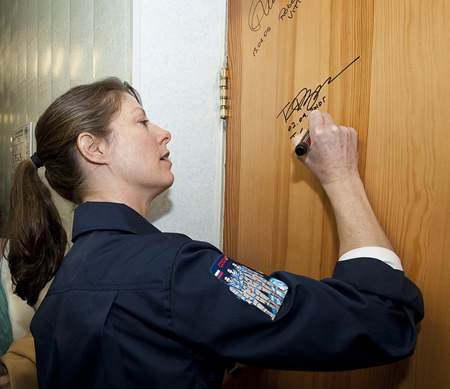
Photo: Expedition 23 Flight Engineer Tracy Caldwell Dyson performs the traditional door signing Friday, April 2, 2010 at the Cosmonaut Hotel in Baikonur, Kazakhstan. Caldwell Dyson was launched onboard the Soyuz rocket later that day with Expedition 23 Soyuz Commander Alexander Skvortsov and Flight Engineer Mikhail Kornienko on a mission to the International Space Station (ISS). Photo Credit: (NASA/Carla Cioffi)
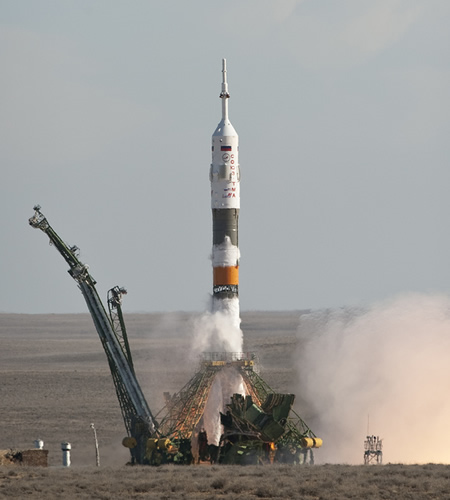
Photo: The Soyuz TMA-18 rocket launches from the Baikonur Cosmodrome in Kazakhstan on Friday, April 2, 2010 carrying Expedition 23 Soyuz Commander Alexander Skvortsov of Russia, Flight Engineer Mikhail Kornienko of Russia and NASA Flight Engineer Tracy Caldwell Dyson of the U.S. to the International Space Station. (Photo Credit: NASA/Carla Cioffi)
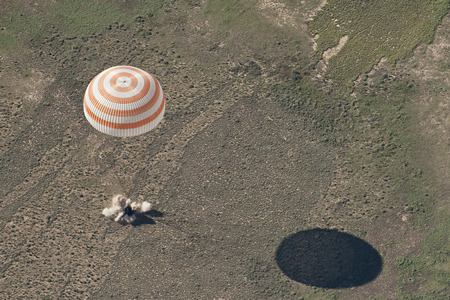
Photo: The Soyuz TMA-17 spacecraft is seen as it lands with Expedition 23 Commander Oleg Kotov and Flight Engineers T.J. Creamer and Soichi Noguchi near the town of Zhezkazgan, Kazakhstan on June 1, 2010. NASA Astronaut Creamer, Russian Cosmonaut Kotov and Japanese Astronaut Noguchi are returning from six months onboard the International Space Station where they served as members of the Expedition 22 and 23 crews. Photo Credit: (NASA/Bill Ingalls)
Expedition 23 Commander Oleg Kotov and Flight Engineers T.J. Creamer and Soichi Noguchi landed their Soyuz-17 spacecraft in Kazakhstan Tuesday, June 1, wrapping up a five-and-a-half-month stay aboard the International Space Station.
Kotov, the Soyuz commander, was at the controls of the spacecraft as it undocked from the aft port on the station's Zvezda module. The crew landed on June 1 at 11:25 p.m., east of Dzhezkazgan, Kazakhstan.
Russian recovery teams were on hand to help the crew exit the Soyuz vehicle and adjust to gravity after 163 days in space. Kotov will return to the Gagarin Cosmonaut Training Center in Star City, outside of Moscow. NASA astronaut Creamer and Japan Aerospace Exploration Agency astronaut Noguchi will return to Houston.
The trio launched aboard the Soyuz TMA-17 spacecraft from the Baikonur Cosmodrome in Kazakhstan on Dec. 21, 2009. As members of the Expedition 22 and 23 crews, they spent 161 days on the station. They supported three space shuttle missions that delivered the U.S. Tranquility module and its cupola; put the finishing touches on U.S. laboratory research facilities; and attached the Russian Rassvet laboratory and storage module.
Kotov has logged 360 total days in space on his two missions, and Creamer has 163 days. Noguchi, who also flew on the STS-114 shuttle mission, has compiled 177 days in space.
A new trio of Expedition 24 flight engineers, Douglas Wheelock, Shannon Walker and Fyodor Yurchickhin, will launch from the Baikonur Cosmodrome at 4:35 p.m. on June 15.
Source: NASA
|GlobalGiants.Com|







Edited & Posted by the Editor | 4:00 AM | View the original post


